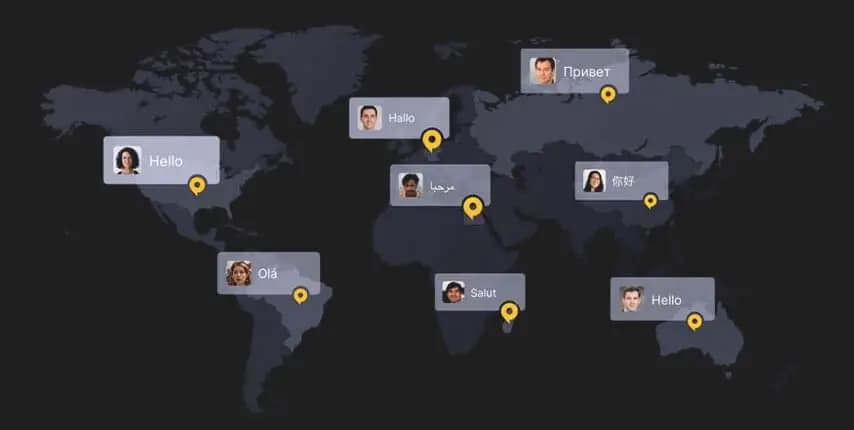Multilingual SEO
It’s well-known for anyone the importance of search engine optimization for websites to appear easily for your audience. If you have globalization goals your SEO might need globalization too. And this can be done through implanting a multilingual SEO to your website content.
Some would say website translation is enough, but the truth is that it might hurt your website instead of helping you achieve your goals. There is a wide range of reasons behind that, let’s find out what the difference is and what your website or eCommerce needs to get into your audience’s first search page.
How Multilingual SEO Strategies Affect the Online Visibility of eCommerce Businesses in Various International Markets?
What is Cross-Cultural Keyword Research? What Is Its Role in Multilingual SEO and Your Website’s Visibility?
Cross-cultural keyword research serves as a bridge that connects diverse audiences to your website. It will enable you to not just understand the words people use to search but understand the cultural nuances that shape those queries. It enables you to uncover the unique phrases, idioms, and search behaviors of different language-speaking communities. When you embrace cross-cultural keyword research, you’re essentially speaking your audience’s language, both literally and figuratively.
By aligning your content with their cultural context, you enhance the user experience and boost your website’s visibility in search results. In today’s interconnected world, where global markets are just a click away, mastering cross-cultural keyword research is the key to unlocking international success and ensuring that your website is not just seen but truly understood by your target audience.
5 Differences Between SEO Translation and SEO Localization
With profound implications for user experience and search engine rankings. SEO translation might seem like the quickest route to make your content accessible in different languages, but it often falls short in capturing the essence of cultural nuances which creates the need to apply a multilingual SEO. On the other hand, full website localization goes beyond language—it adapts your content to the cultural and regional specificities of your target audience. This approach not only ensures linguistic accuracy but also resonates emotionally, enhancing user engagement and trust. In the eyes of search engines, localized content stands out as more relevant and authentic, ultimately leading to improved rankings. So, while translation can be a starting point, the true SEO goldmine lies in the depth of localization and using a multilingual SEO, where cultural adaptation becomes the secret weapon for reaching global audiences effectively.
These are some of the differences SEO translation and multilingual SEO:
Cultural Adaptation: Multilingual SEO involves not only translating content but also adapting it to the cultural norms, preferences, and sensitivities of the target audience. Simple translation, on the other hand, focuses solely on linguistic conversion, potentially missing the cultural nuances crucial for resonating with users.
Enhanced User Experience: Localization aims to create a seamless and culturally relevant user experience by tailoring content, images, and design to the specific audience. This results in higher user engagement and satisfaction. In contrast, basic translation may lead to content that feels out of place or confusing for users.
Search Engine Relevance: Search engines favor localized content because it provides a more comprehensive user experience. Localized websites tend to rank higher in search results as they are perceived as more relevant and authoritative by search engine algorithms. Translated content may not have the same impact on search engine rankings.
Keyword Optimization: In multilingual SEO, keyword research is adapted for each target market, ensuring that the content uses the most relevant and high-traffic keywords in the local language. In simple translation, keyword optimization may be overlooked, resulting in less effective SEO.
Global Reach: Localization opens doors to new markets and allows businesses to effectively target diverse audiences worldwide. Simple translation, while providing basic accessibility, often falls short in engaging and connecting with global consumers, limiting the potential for international growth.
Tips for Technical SEO Challenges in Multilingual Websites
Multilingual SEO can increase website traffic, increasing the likelihood of high conversion rates and revenue. But some problems can be addressed if not taken care of the technical SEO part, websites could be impacted by a number of issues.
Lack Of a Solid URL Structure: URLs improve user experience by allowing the target audience to browse the multilingual website’s many language versions. Additionally, they provide search engines with information about the page’s content to guarantee accurate indexing and language targeting. The lack of properly constructed URLs can degrade the user experience and result in inaccurate indexing.
Poor Content Translation and Optimization: For multilingual websites, it might be difficult to translate the material into several languages while preserving its context and SEO factors. For instance, it can be challenging to translate text from Spanish into English while including pertinent keywords from the source language. Furthermore, precise translations may alter the original content’s meaning, undermining its SEO strategy.
Duplicate Content Issues: Similar or identical material that appears on numerous pages of a website in different languages raises duplicate content issues in multilingual SEO. Although it can seem like a straightforward way to offer material in several languages, search engines like Google penalize duplicate content because it can generate confusion and a bad user experience. Duplicate content issues in multilingual websites can impact website’s performance, here is how:
SEO Ranking: Duplicate content issues leave the search engines confused and have no power to decide which version to show in search results.
User Confusion: Duplicate content in multilingual websites can confuse users, especially when they land on a page that’s not in their preferred language, leading to high bounce rates, as visitors may leave the site in search of another content that matches their language preference.
Crawl Budget: Search engine bots have limited resources and time to crawl websites. When they encounter duplicate content, they may spend less time crawling other important pages on your site, potentially missing valuable content.
To address duplicate content issues in multilingual SEO, use these strategies:
4.The Importance of Understanding User Behavior in Multilingual Search
Understanding user behavior in multilingual search is pivotal for tailoring effective multilingual SEO strategies that resonate with diverse audiences across languages and cultures. Looking at user behavior in multilingual search will help you with these aspects:- Language-Driven Search Behavior: In different languages, users communicate their search intent in different ways. Even for the same subject, there can be significant variation in the words and phrases chosen. Keyword research in each language is essential for multilingual SEO to be successful, as it ensures that the content matches the linguistic nuances that users use while searching.
– Cultural Sensitivities: Cultural influences have a significant impact on how users look for and perceive information. What is a popular search word in one culture may be seen differently or have little importance in another. Multilingual SEO methods must account for these cultural sensitivities in order to create content that adheres to cultural conventions and values.
– Local Trends and Events: Current events and trends have a large influence on search behavior. Specific searches can be influenced by local news, holidays, or events. When applicable, multilingual SEO methods should be adaptable enough to capitalize on these trends. For example, the National Day of Saudi Arabia was a great trend that reached a great number of searches on search engines and was a great trend for brands to follow.
User Expectations: When it comes to the format and style of content, users have various expectations. Some cultures may favor factual information that is brief, but others may prefer a more narrative or storytelling approach. User engagement can be increased by adapting content to suit these expectations.
Assessing the Financial Benefits Against the Costs associated with Multilingual SEO Strategies to See Its ROI
Multilingual SEO is crucial for businesses looking to expand into global markets. Here are some of the effects that implanting a multilingual SEO plan could affect business:
– Increasing Organic Traffic: The most noticeable immediate result of excellent multilingual SEO is an increase in organic traffic from international markets. Businesses can reach a larger audience by optimizing localized content for several languages. The increase in website visits, page views, and interaction from these new overseas visitors is significant that businesses should consider multilingual SEO to get it.
– Improving Conversion Rates: Multilingual SEO is vital for increasing conversion rates since it ensures that your website speaks the language of your broad audience. When potential customers can access content in their preferred language, they feel more at ease and engaged, increasing their likelihood of conversion. This personalized experience not only builds trust but also removes any linguistic hurdles that may have prevented customers from doing the required action, whether it’s making a purchase, filling out a form, or subscribing. Multilingual SEO delivers a smooth and user-centric environment that greatly enhances conversion rates, eventually driving business success in worldwide markets by meeting your audience’s linguistic and cultural needs.
– Enhancing Brand Visibility: Multilingual SEO raises a brand’s global visibility by optimizing its online presence so that it appears prominently in search engine results for several languages and countries. When your content is adapted to target audiences’ linguistic and cultural preferences, search engines recognize its relevance and authenticity, resulting in higher ranks. This rise in visibility not only boosts organic traffic but also raises your brand’s credibility and reliability in overseas marketplaces. As search engines prioritize localized search results, multilingual SEO guarantees that your brand constantly appears at the top, boosting your reach and securing your position in global search engine rankings.
– Customer Lifetime Value: Multilingual SEO has a significant impact on raising CLV and promoting client retention and loyalty. You build a personalized and engaging environment that connects with your diverse consumer base’s cultural and linguistic preferences by delivering content and user experiences in their native languages. This not only helps with initial conversions but also strengthens the emotional bond between your company and its clients. Customers are more likely to return for repeat purchases and become long-term advocates when they feel understood and cared for. Multilingual SEO ensures continuous visibility, relevance, and accessibility in international marketplaces, cultivating long-term relationships.
– Long-term Growth: By optimizing your online presence for many languages and cultures, you lay the groundwork for long-term reach and engagement with diverse worldwide audiences. This results in consistent, organic visitor increases from multiple regions, as well as higher search engine rankings that last. You should expect continuing client acquisition and retention, delivering sustained revenue growth, as your brand becomes synonymous with relevance and trustworthiness in these regions. Furthermore, multilingual SEO broadens your market footprint, minimizing reliance on a single market and making your company more adaptable to economic volatility. Multilingual SEO is, in essence, a long-term strategy for establishing and maintaining worldwide market success and sustainable growth.













